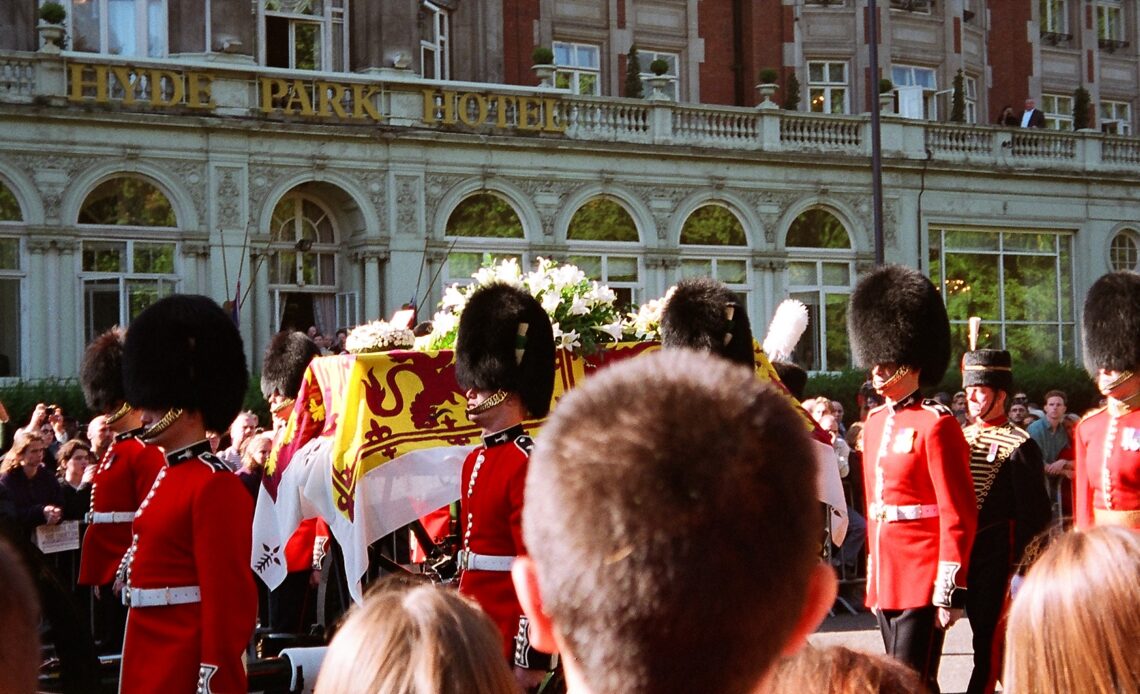
When a member of the Royal Family dies, a funeral plan is usually ready. In the case of Diana, Princess of Wales, things were much different, especially since she had just finalised her divorce from Prince Charles.
The Royal Family had just a week to organise Diana’s funeral. A planning committee was set up, including people from St James’s, Kensington, and Buckingham Palaces, representatives from Number 10, the police, and Diana’s family. There were tensions over funeral arrangements, including who should walk behind the coffin. Princes William (15 at the time) and Harry (12) were hesitant about walking behind their mother’s coffin during the procession. Anji Hunter, who was then-Prime Minister Tony Blair’s adviser, recalled the concept during a Channel 5 Documentary, Diana: 7 Days That Shook The Windsors:
“I can remember, and it sends a tingle up my back thinking about it; we were talking and then from the speaker-phone on the table came Prince Philip’s voice.
“And it was anguished, [he said] ‘These are the boys here, we are talking about these boys, they have lost their mum’. It brought it all home to us.”
[getty src=”52101806″ width=”594″ height=”426″ tld=”com”]Prince Philip famously told his grandsons, “I’ll walk if you walk.”
The boys agreed and walked to Westminster Abbey alongside Philip, Earl Spencer (Diana’s brother,) and their father, Prince Charles. During the walk, Philip quietly spoke to the boys about the historic London landmarks they passed to help “keep [them] from breaking down.” William later said it was one of the hardest things he had to do, but it was an act necessary to maintain the balance between “duty and family.” As for Harry, he said that no child should be asked to do what they did.
Allegedly, William and Harry were told not to cry at the funeral. It’s claimed Prince Charles told Harry, who was sobbing, “You don’t cry, you walk.” Royals are often expected to keep emotions to themselves during public appearances. Dickie Arbiter, the former press secretary to Queen Elizabeth II, told Express:
“There’s an old saying in royal circles, don’t wear prairie grief on a public sleeve. And they didn’t.”
The morning of her death on 31 August, her sons, who were staying at Balmoral Castle in Scotland, were allowed to sleep in rather than being woken up to be told their mother died. The Queen ordered all TVs and radios to be moved or hidden in fear of traumatising the boys with details of their mother’s death. When Charles flew to Paris to collect Diana’s body, Harry begged his dad to come with him. The Queen initially barred Charles from taking the royal private plane for the trip.
The Queen faced controversy as she didn’t speak on Diana’s death for nearly a week until the eve of her funeral. In a historic address to the nation, she called Diana “an exceptional and gifted human being.” Although some say her response was “cold.” The 2006 film The Queen follows the initial reluctance of Buckingham Palace to mourn Diana publicly.
[getty src=”543728830″ width=”594″ height=”396″ tld=”com”]Funeral organisers were unsure if they could fill Westminster Abbey with enough people. The Princess’s private secretary, Patrick Jepson, explained that there was no rule book or precedent to go off of, nor was there a tradition for reference. He told organisers that if they went off a guest list for the Princess’s Christmas drinks in 1995, no one important would be missed. The Abbey was filled with 2,000 people, and an estimated two million people lined London streets to watch the cortège travel a little over six kilometres across the capital.
[getty src=”1150395″ width=”444″ height=”594″ tld=”com”]Initially, the funeral wasn’t even going to be public. Her ex-husband reportedly insisted on making the funeral public after seeing the response to her death and how much she meant to the public. Despite resistance, Charles and then-Prime Minister Tony Blair eventually convinced The Queen to make the funeral public. Because there was no formal funeral plan in place, Diana’s funeral was based on “Operation Tay Bridge,” the codenamed funeral plan for The Queen Mother. By that point, the plan had been practised for 22 years.
Diana’s brother faced his own controversy because of his eulogy. He criticised how the Royal Family and paparazzi treated Diana. The Queen was reportedly angered by his words:
“Someone with a natural nobility who was classless and who proved in the last year that she needed no royal title to continue to generate her particular brand of magic” and “I pledge that we, your blood family, will do all we can to continue the imaginative and loving way in which you were steering these two exceptional young men so that their souls are not simply immersed by duty and tradition, but can sing openly as you planned.”
Diana was privately buried at her childhood home of Althrop in West Northamptonshire. Her casket had been covered with the Royal Standard featuring an emine border (i.e. the Other Members’ standard.) Just moments before she was placed in the ground, Diana’s brother replaced the standard with the Spencer family flag and allegedly said, “She is a Spencer Now.”
Diana’s former butler, Paul Burrell, condemned the move and said it had more to do with the Spencer versus Windsor war rather than what Diana would have wanted. Additionally, he thought it was disrespectful and inappropriate. In response, Earl Spencer said the comments were “hurtful lies.”

